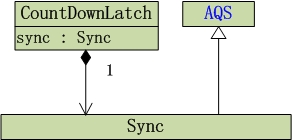概要
??和ReadWriteLock.ReadLock一样,CountDownLatch的本质也是一个"共享锁"。
CountDownLatch简介
??CountDownLatch是一个同步辅助类,在完成一组正在其他线程中执行的操作之前,它允许一个或多个线程一直等待。
CountDownLatch和CyclicBarrier的区别:
①CountDownLatch的作用是允许1或N个线程等待其他线程完成执行;而CyclicBarrier则是允许N个线程相互等待。
② CountDownLatch的计数器无法被重置;CyclicBarrier的计数器可以被重置后使用,因此它被称为是循环的barrier。
CountDownLatch方法列表
CountDownLatch(int count)//构造一个用给定计数初始化的 CountDownLatch
// 使当前线程在锁存器倒计数至零之前一直等待,除非线程被中断
void await()
// 使当前线程在锁存器倒计数至零之前一直等待,除非线程被中断或超出了指定的等待时间
boolean await(long timeout, TimeUnit unit)
// 递减锁存器的计数,如果计数到达零,则释放所有等待的线程
void countDown()
// 返回当前计数
long getCount()
// 返回标识此锁存器及其状态的字符串
String toString()
CountDownLatch数据结构
CountDownLatch的UML类图:

CountDownLatch的数据结构很简单,它是通过"共享锁"实现的。它包含了sync对象,sync是Sync类型。Sync是实例类,它继承于AQS。
CountDownLatch源码分析
public class CountDownLatch {
/*** Synchronization control For CountDownLatch.* Uses AQS state to represent count.*/private static final class Sync extends AbstractQueuedSynchronizer {
private static final long serialVersionUID = 4982264981922014374L;Sync(int count) {
setState(count);}int getCount() {
return getState();}protected int tryAcquireShared(int acquires) {
return (getState() == 0) ? 1 : -1;}protected boolean tryReleaseShared(int releases) {
// Decrement count; signal when transition to zerofor (;;) {
int c = getState();if (c == 0)return false;int nextc = c-1;if (compareAndSetState(c, nextc))return nextc == 0;}}}private final Sync sync;/*** Constructs a {@code CountDownLatch} initialized with the given count.** @param count the number of times {@link #countDown} must be invoked* before threads can pass through {@link #await}* @throws IllegalArgumentException if {@code count} is negative*/public CountDownLatch(int count) {
if (count < 0) throw new IllegalArgumentException("count < 0");this.sync = new Sync(count);}/*** Causes the current thread to wait until the latch has counted down to* zero, unless the thread is {@linkplain Thread#interrupt interrupted}.** <p>If the current count is zero then this method returns immediately.** <p>If the current count is greater than zero then the current* thread becomes disabled for thread scheduling purposes and lies* dormant until one of two things happen:* <ul>* <li>The count reaches zero due to invocations of the* {@link #countDown} method; or* <li>Some other thread {@linkplain Thread#interrupt interrupts}* the current thread.* </ul>** <p>If the current thread:* <ul>* <li>has its interrupted status set on entry to this method; or* <li>is {@linkplain Thread#interrupt interrupted} while waiting,* </ul>* then {@link InterruptedException} is thrown and the current thread's* interrupted status is cleared.** @throws InterruptedException if the current thread is interrupted* while waiting*/public void await() throws InterruptedException {
sync.acquireSharedInterruptibly(1);}/*** Causes the current thread to wait until the latch has counted down to* zero, unless the thread is {@linkplain Thread#interrupt interrupted},* or the specified waiting time elapses.** <p>If the current count is zero then this method returns immediately* with the value {@code true}.** <p>If the current count is greater than zero then the current* thread becomes disabled for thread scheduling purposes and lies* dormant until one of three things happen:* <ul>* <li>The count reaches zero due to invocations of the* {@link #countDown} method; or* <li>Some other thread {@linkplain Thread#interrupt interrupts}* the current thread; or* <li>The specified waiting time elapses.* </ul>** <p>If the count reaches zero then the method returns with the* value {@code true}.** <p>If the current thread:* <ul>* <li>has its interrupted status set on entry to this method; or* <li>is {@linkplain Thread#interrupt interrupted} while waiting,* </ul>* then {@link InterruptedException} is thrown and the current thread's* interrupted status is cleared.** <p>If the specified waiting time elapses then the value {@code false}* is returned. If the time is less than or equal to zero, the method* will not wait at all.** @param timeout the maximum time to wait* @param unit the time unit of the {@code timeout} argument* @return {@code true} if the count reached zero and {@code false}* if the waiting time elapsed before the count reached zero* @throws InterruptedException if the current thread is interrupted* while waiting*/public boolean await(long timeout, TimeUnit unit)throws InterruptedException {
return sync.tryAcquireSharedNanos(1, unit.toNanos(timeout));}/*** Decrements the count of the latch, releasing all waiting threads if* the count reaches zero.** <p>If the current count is greater than zero then it is decremented.* If the new count is zero then all waiting threads are re-enabled for* thread scheduling purposes.** <p>If the current count equals zero then nothing happens.*/public void countDown() {
sync.releaseShared(1);}/*** Returns the current count.** <p>This method is typically used for debugging and testing purposes.** @return the current count*/public long getCount() {
return sync.getCount();}/*** Returns a string identifying this latch, as well as its state.* The state, in brackets, includes the String {@code "Count ="}* followed by the current count.** @return a string identifying this latch, as well as its state*/public String toString() {
return super.toString() + "[Count = " + sync.getCount() + "]";}
}
CountDownLatch是通过“共享锁”实现的。下面,分析一下CountDownLatch中的3个核心函数: CountDownLatch(int count)、await()、countDown()。
1、CountDownLatch(int count)
public CountDownLatch(int count) {
if (count < 0) throw new IllegalArgumentException("count < 0");this.sync = new Sync(count);
}
说明:该函数是创建一个Sync对象,而Sync是继承于AQS类。Sync构造函数如下:
Sync(int count) {
setState(count);
}
setState()在AQS中实现,源码如下:
protected final void setState(long newState) {
state = newState;
}
说明:在AQS中,state是一个private volatile long类型的对象。对于CountDownLatch而言,state表示的是”锁计数器“。CountDownLatch中的getCount()最终是调用AQS中的getState(),返回的就是state对象,即”锁计数器“。
2、await()
public void await() throws InterruptedException {
sync.acquireSharedInterruptibly(1);
}
说明:该函数实际上是调用的AQS的acquireSharedInterruptibly(1),AQS中的acquireSharedInterruptibly()的源码如下:
public final void acquireSharedInterruptibly(long arg)throws InterruptedException {
if (Thread.interrupted())throw new InterruptedException();if (tryAcquireShared(arg) < 0)doAcquireSharedInterruptibly(arg);
}
说明:acquireSharedInterruptibly()的作用是获取共享锁。如果当前线程是中断状态,则抛出异常InterruptedException。否则,调用tryAcquireShared(arg)尝试获取共享锁,尝试成功则返回,否则就调用doAcquireSharedInterruptibly()。doAcquireSharedInterruptibly()会使当前线程一直等待,直到当前线程获取到共享锁(或被中断)才返回。tryAcquireShared()在CountDownLatch.java中被重写,它的源码如下:
protected int tryAcquireShared(int acquires) {
return (getState() == 0) ? 1 : -1;
}
说明:tryAcquireShared()的作用是尝试获取共享锁。如果"锁计数器=0",即锁是可获取状态,则返回1;否则,锁是不可获取状态,则返回-1。
private void doAcquireSharedInterruptibly(long arg) throws InterruptedException {
// 创建"当前线程"的Node节点,且Node中记录的锁是"共享锁"类型;并将该节点添加到CLH队列末尾final Node node = addWaiter(Node.SHARED);boolean failed = true;try {
for (;;) {
// 获取上一个节点// 如果上一节点是CLH队列的表头,则"尝试获取共享锁"final Node p = node.predecessor();if (p == head) {
long r = tryAcquireShared(arg);if (r >= 0) {
setHeadAndPropagate(node, r);p.next = null; // help GCfailed = false;return;}}// (上一节点不是CLH队列的表头) 当前线程一直等待,直到获取到共享锁// 如果线程在等待过程中被中断过,则再次中断该线程(还原之前的中断状态)if (shouldParkAfterFailedAcquire(p, node) &&parkAndCheckInterrupt())throw new InterruptedException();}} finally {
if (failed)cancelAcquire(node);}
}
说明:
①addWaiter(Node.SHARED)的作用是,创建”当前线程“的Node节点,且Node中记录的锁的类型是”共享锁“(Node.SHARED);并将该节点添加到CLH队列末尾。
②node.predecessor()的作用是,获取上一个节点。如果上一节点是CLH队列的表头,则”尝试获取共享锁“。
③shouldParkAfterFailedAcquire()的作用和它的名称一样,如果在尝试获取锁失败之后,线程应该等待,则返回true;否则,返回false。
④当shouldParkAfterFailedAcquire()返回ture时,则调用parkAndCheckInterrupt(),当前线程会进入等待状态,直到获取到共享锁才继续运行。
3、countDown()
public void countDown() {
sync.releaseShared(1);
}
说明:该函数实际上调用releaseShared(1)释放共享锁。releaseShared()在AQS中实现,源码如下:
public final boolean releaseShared(int arg) {
if (tryReleaseShared(arg)) {
doReleaseShared();return true;}return false;
}
说明:releaseShared()的目的是让当前线程释放它所持有的共享锁。它首先会通过tryReleaseShared()去尝试释放共享锁。尝试成功,则直接返回;尝试失败,则通过doReleaseShared()去释放共享锁。tryReleaseShared()在CountDownLatch.java中被重写,源码如下:
protected boolean tryReleaseShared(int releases) {
// Decrement count; signal when transition to zerofor (;;) {
// 获取“锁计数器”的状态int c = getState();if (c == 0)return false;// “锁计数器”-1int nextc = c-1;// 通过CAS函数进行赋值if (compareAndSetState(c, nextc))return nextc == 0;}
}
说明:tryReleaseShared()的作用是释放共享锁,将“锁计数器”的值-1。
总结:CountDownLatch是通过“共享锁”实现的。在创建CountDownLatch时,会传递一个int类型参数count,该参数是“锁计数器”的初始状态,表示该“共享锁”最多能被count个线程同时获取。当某线程调用该CountDownLatch对象的await()方法时,该线程会等待“共享锁”可用时,才能获取“共享锁”进而继续运行。而“共享锁”可用的条件,就是“锁计数器”的值为0!而“锁计数器”的初始值为count,每当一个线程调用该CountDownLatch对象的countDown()方法时,才将“锁计数器”-1;通过这种方式,必须有count个线程调用countDown()之后,“锁计数器”才为0,而前面提到的等待线程才能继续运行。这就是CountDownLatch的实现原理。
CountDownLatch的使用示例
下面通过CountDownLatch实现:"主线程"等待"5个子线程"全部都完成"指定的工作(休眠1000ms)"之后,再继续运行:
import java.util.concurrent.CountDownLatch;
import java.util.concurrent.CyclicBarrier;public class CountDownLatchTest1 {
private static int LATCH_SIZE = 5;private static CountDownLatch doneSignal;public static void main(String[] args) {
try {
doneSignal = new CountDownLatch(LATCH_SIZE);// 新建5个任务for(int i=0; i<LATCH_SIZE; i++)new InnerThread().start();System.out.println("main await begin.");// "主线程"等待线程池中5个任务的完成doneSignal.await();System.out.println("main await finished.");} catch (InterruptedException e) {
e.printStackTrace();}}static class InnerThread extends Thread{
public void run() {
try {
Thread.sleep(1000);System.out.println(Thread.currentThread().getName() + " sleep 1000ms.");// 将CountDownLatch的数值减1doneSignal.countDown();} catch (InterruptedException e) {
e.printStackTrace();}}}
}
//结果
main await begin.
Thread-0 sleep 1000ms.
Thread-2 sleep 1000ms.
Thread-1 sleep 1000ms.
Thread-4 sleep 1000ms.
Thread-3 sleep 1000ms.
main await finished.
结果说明:主线程通过doneSignal.await()等待其它线程将doneSignal递减至0。其它的5个InnerThread线程,每一个都通过doneSignal.countDown()将doneSignal的值减1;当doneSignal为0时,main被唤醒后继续执行。